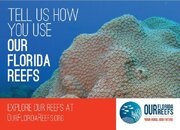ac1724
Registered
Nova Southeastern University Joins Florida Department of Environmental Protection to Learn How Reefs Are Being Used
FORT LAUDERDALE-DAVIE, Fla. – Florida is world-famous for its pristine beaches, abundant sunshine and the various watersports it offers both visitors and residents. Many of those ocean activities involve our coral reefs in some way, shape or form. Whether it’s a day of scuba diving, fishing for the next “big catch” or taking part in mini-lobster season, our reefs are a major attraction. But there’s more to the story – our reefs are in trouble.“Since the 1960s, NSU’s Oceanographic Center has been working to learn more about our marine environment, the role it plays and how we can be better stewards of this natural resource,” said Richard Dodge, Ph.D., dean of the Oceanographic Center. “Today, more than ever, it’s vital that we continue to learn how to strike a balance between enjoying our precious resources in the sea and ensuring that they remain vibrant and thrive for generations to come.”To that end, Nova Southeastern University’s Oceanographic Centerhas teamed up with the Florida Department of Environmental Protection and the Southeast Florida Coral Reef Initiative (SEFCRI) to launch the Our Florida Reefs coastal and ocean use survey. This survey is being conducted as part of a local initiative for our area, known as Our Florida Reefs. The survey is intended for anyone – local, state, national or international – who has enjoyed the coral reefs in Southeast Florida to provide information on their experiences. You can find the survey by visiting Our Florida Reefs webpage at www.ourfloridareefs.org and click on the MAPPING tab.Brian Walker, Ph.D., a researcher at NSU’s Oceanographic Center, has coordinated a group of local stakeholders, agency representatives and computer programmers from Point 97 in Oregon to develop a reef-use survey to poll the public. “The data collected from the survey will provide essential information for developing appropriate management strategies whilst affecting the least amount of users,” Walker said.By providing information on where you fish, dive, boat, surf, etc. local residents, reef users, business owners, visitors and the broader public in Miami-Dade, Broward, Palm Beach, and Martin will be part of the data used by the Our Florida Reefs Community Working Groups to enhance recommendations on managing our reefs to better balance resource use and protection while ensuring healthy coral reefs for future generations.Coral reefs are not visible to most people, so the old “out of sight, out of mind” paradigm plays a role in this equation. The idea is to shift that dynamic so everyone understands the importance of our reefs from both an environmental and economic standpoint for Southeast Florida.







